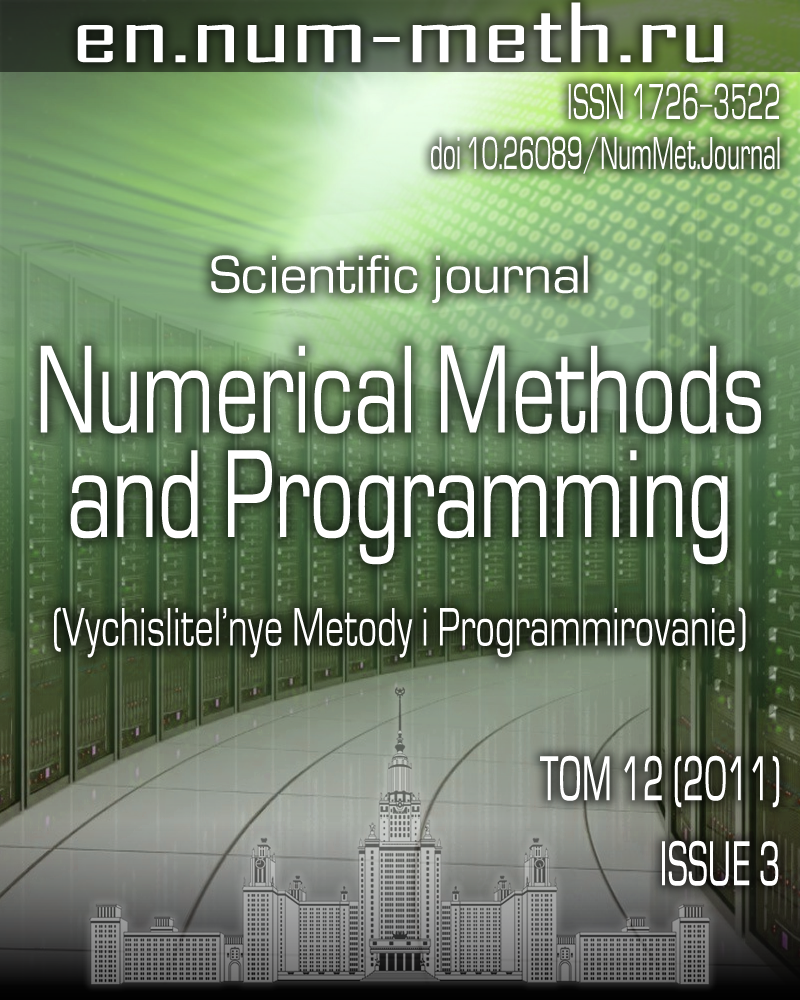A finite-difference method for the numerical simulation of seismic wave propagation through multiscale media
Keywords:
Abstract
In order to simulate the interaction of seismic waves with cavernous-fractured reservoirs, a finite-difference method based on locally refined time-space grids is used. The need to use these grids is due primarily to a different scale of heterogeneities in the surrounding medium and the reservoir. The domain decomposition methods allow one to separate the target area into subdomains containing the surrounding medium (a coarse grid) and the reservoir (a fine grid). Computations for each subdomain can be carried out in parallel. The data exchange between each subdomain within a group is done using MPI through nonblocking iSend/iReceive commands. The data exchange between the two groups is done simultaneously by coupling the coarse and fine grids. Some results of the numerical simulation of a carbonate reservoir are presented and discussed.
Downloads
Published
Issue
Section
References
- Рытов С.М., Кравцов Ю.А., Татарский В.И. Введение в статистическую радиофизику. Часть II (стохастические поля). М.: Наука, 1978.
- Самарский А.А. Теория разностных схем. М.: Наука, 1977.
- Castro C.E., Kaser M., Toro E.F. Space-time numerical methods for geophysical applications // Phil. Trans. of the Royal Society. Series A. 2009. 367. 4613-4631.
- Collino F., Fouquet T., Joly P. A conservative space-time mesh refinement method for 1D wave equation. Part I: Construction // Numerische Mathematik. 2003. 95. 197-221.
- Collino F., Fouquet T., Joly P. A conservative space-time mesh refinement method for 1D wave equation. Part II: Analysis // Numerische Mathematik. 2003. 95. 223-251.
- Diaz J., Grote M.J. Energy conserving explicit local time stepping for second-order wave equations // SIAM J. Sci. Comput. 2009. 31, N 3. 1985-2014.
- Grechka V. Multiple cracks in VTI rocks: Effective properties and fracture characterization // Geophysics. 2007. 72, N 5. D81-D91.
- Lisitsa V., Reshetova G., Tcheverda V. Finite-difference algorithm with local time-space grid refinement for simulation of waves // Computational Geosciences. 2011. 1-16
doi 10.1007/s10596-011-9247-1 - Reshef M., Landa E. Post-stack velocity analysis in the dip-angle domain using diffractions // Geophysical Prospecting. 2009. 57. 811-821.
- Saenger E.H., Kruger O.K., Shapiro S.A. Effective elastic properties of randomly fractured soils: 3D numerical experiments // Geophysical Prospecting. 2004. 51. 183-195.
- Sneider Roel. The theory of coda wave interferometry // Pure and Applied Geophysics. 2004. 163. 455-473.
- Tsingas C., El Marhfoul B., Dajani A. Fracture detection by diffraction imaging // 72nd EAGE Conference and Exhibition incorporating SPE EUROPEC. 14-17 June, 2010. Barcelona, Spain. G044.
- Virieux J. P-SV wave propagation in heterogeneous media: velocity-stress finite difference method // Geophysics. 1986. 51, N 4. 889-901.
- Willis M., Burns D., Rao R., Minsley B., Toksoz N., Vetri L. Spatial orientation and distribution of reservoir fractures from scattered seismic energy // Geophysics. 2006. 71. O43-O51.


